Tamino and Real Climate are both way too polite to say that whoever the referees were who reviewed the manuscript and said that it should be accepted for publication either are dimwits, not doing their job properly, or perhaps were paid for their efforts, but that's just my opinion.
"Old News," from Tamino's Open Mind blog
July 24, 2009 · 40 Comments
The denialosphere is atwitter about a new paper by McLean, Freitas, and Carter (2009, J. Geophysical Res., 114, D14104). They seek to relate variations in tropospheric temperature to the Southern Oscillation Index (SOI). The concluding sentence is:
Finally, this study has shown that natural climate forcing associated with ENSO is a major contributor to variability and perhaps recent trends in global temperature, a relationship that is not included in current global climate models.
That ENSO is a major contributor to variability in global temperature, is ancient news. In fact, I’ve shown it myself.
That ENSO is a major contributor to recent trends in global temperature, they have not shown — not even “perhaps.” In fact, it’s downright impossible for their methodology to do so.
The reason for the celebratory tone in denialist web posts (Grima Wormtongue is especially excited) is the extreme correlation claimed between SOI and tropospheric temperature.
Change in SOI accounts for 72% of the variance in GTTA for the 29-year-long MSU record and 68% of the variance in GTTA for the longer 50-year RATPAC record.
(“GTTA” is “global tropospheric temperature anomaly.”) Even stronger correlation is claimed for tropical tropospheric temperature.
Although it’s not stated outright, the paper clearly implies that the strong correlation accounts for so much of the tropospheric temperature variation that little is left to attribute to greenhouse gases. One of the authors, Bob Carter, does say so outright in a press release related to the paper:
“The close relationship between ENSO and global temperature, as described in the paper, leaves little room for any warming driven by human carbon dioxide emissions.”
We already knew that there’s strong correlation between SOI (or other El Nino measures like MEI) and temperature, whether surface or tropospheric temperature, whether global or tropical. But the real reason they note such strong correlation is that their analysis method removes all temperature variation which is due to trend — which of course makes it impossible for their analysis to indicate anything whatever about the trend.
First, they analyze 12-month running averages rather than raw data. This won’t by itself inflate the correlation, although it does make correlation estimates much more uncertain (by introducing strong false autocorrelation). More to the point, they don’t compute correlation between temperature and SOI, but between the time derivatives of temperature and SOI. They estimate time derivatives by taking the difference between 12-month running averages, 12 months apart.
And therein lies the problem. Suppose temperature is the sum of a function of time which shows a lot of variation but no trend, and a linear trend
.
where is the warming rate of the trend, and the function
has no trend whatever. Now let’s estimate the derivative (with respect to time) by taking the difference between temperature at any given time and its value 1 year (12 months) earlier
.
Note that the coefficient of is now 1 rather than
, i.e., the trend in the data has been reduced to a constant by the process of estimating the derivative. Therefore, they’ve eliminated all the variation due to trend, before estimating correlation. And when we then correlate the difference series
to any variable, the warming rate
will have no impact whatever, because adding a constant to a data series has no effect on its correlation with anything. Hence their methodology automatically eliminates any impact of the trend rate in the data series on the resultant correlation.
Allow me to illustrate.
Let’s start with the SOI data they use and the UAH tropospheric temperature data they use [Note: they explicitly state they're using "lower troposphere" UAH data, but the link they give is to mid-troposphere UAH data; it has no effect on the argument]. Now let’s do as they do and compute 12-month running means (I’ve rescaled the SOI data according to the formula determined by the authors):
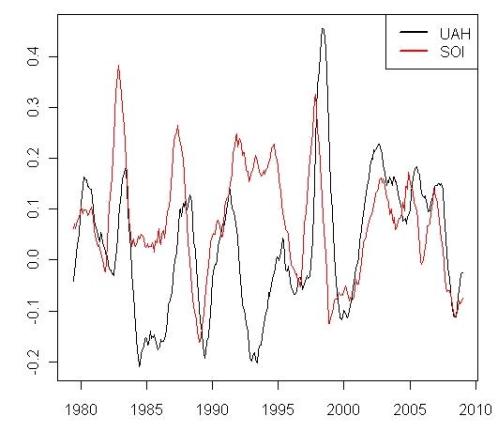
We can already see a strong correlation, and that there’s a lag between the SOI and the temperature — but as I’ve already said, we already knew that. The times when the correlation breaks down are the times following major volcanic eruptions (we already knew that, too).
Now let’s estimate derivatives by taking the difference between each variable and its value 1 year previously (I’ll plot the derivative of SOI data lagged by 7 months, the lag chosen by the authors, to emphasize the correlation):
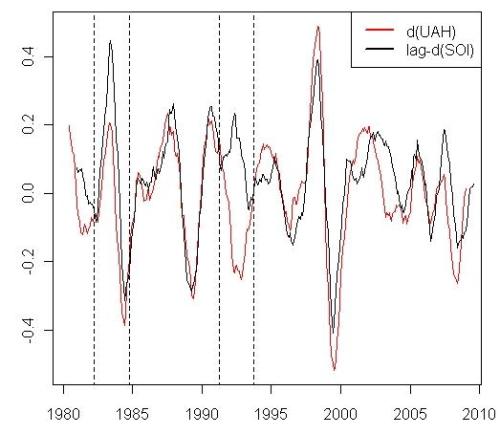
The dashed lines indicate times during which major volcanic eruptions (el Chicon and Mt. Pinatubo) have an impact. They eliminate those time intervals from the data, but we don’t need to in order to make the point. When we compute the cross-correlation function, we see that there’s strong correlation when lags
by about 6 months (they get 7 months, but not only did I not bother to eliminate the volcanic episodes, I’ve also used data all the way through June 2009):
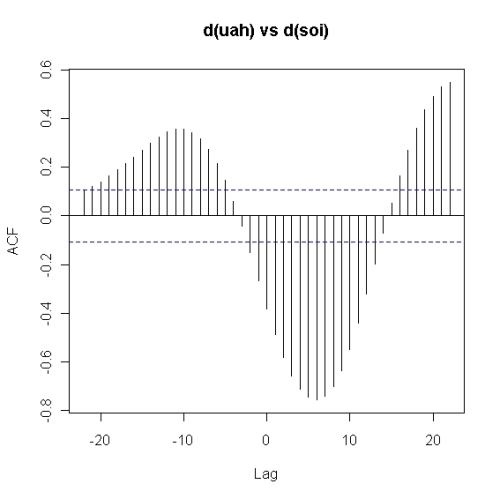
Now let’s repeat the exact same analysis, but first let’s add a huge artificial trend to the temperature data so it looks like this:
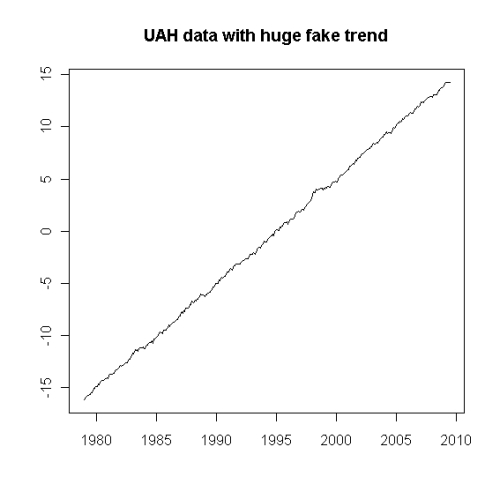
Now let’s take 12-month running averages, then difference the time series at 1 year, then compute the cross-correlation again:
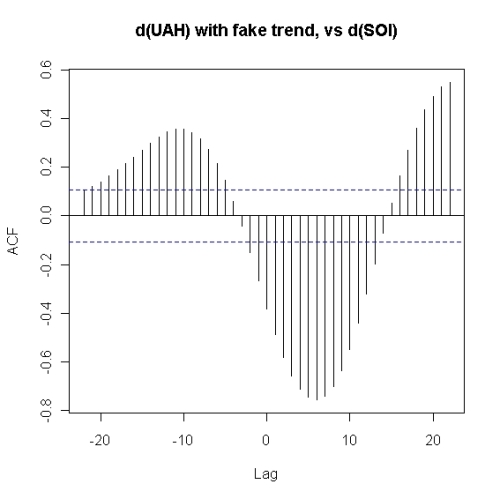
Does that look familiar?
It should. The correlation between the derivatives of temperature and of SOI is utterly unchanged when I introduce a trend into either of the time series — no matter how big or small the trend might be. The fact is that their methodology — the process of estimating derivatives by taking 1-year differences — transforms any trend into a constant and thereby eliminates its impact on all variation and correlation.
It’s certainly not true that their analysis shows “natural climate forcing associated with ENSO is a major contributor to variability and perhaps recent trends in global temperature.” It shows no such thing; their analysis removes all the effect of trends.
Their only justification for the claim that ENSO has affected trends is to point out that “For the 30 years prior to the 1976 shift (i.e., 1946–1975), the SOI averaged +1.93, but in the 30 years after 1976 (i.e., 1977–2006), the average was -3.06, which represents a shift from a La Nina inclination to an El Nino inclination.” While a shift from La Nina to El Nino can cause a shift in temperature, there’s no evidence at all (nor do the authors provide any) that it can introduce a trend. This argument is nothing more than hand-waving, and is only apparently supported by the strong correlation they estimate using a methodology which eliminates all effect of trends.
Bob Carter’s statement in particular, that “The close relationship between ENSO and global temperature, as described in the paper, leaves little room for any warming driven by human carbon dioxide emissions,” shows how little he understand the analysis he himself participated in. Of course, he wouldn’t be the first to fail to understand the impact of using estimated derivatives on correlation analysis.
A valid way to estimate the impact of El Nino on global temperature is to use multiple regression on actual data rather than on estimates of time derivatives. One can include the impact of volcanoes, El Nino, solar changes, and greenhouse gases. When one does so, it’s clear that without the influence of man-made climate forcing it’s just not possible to explain the trend in global temperature. But I’m hardly the first to point that out.
Link to Tamino's Open Mind blog entry: http://tamino.wordpress.com/2009/07/24/old-news/







No comments:
Post a Comment